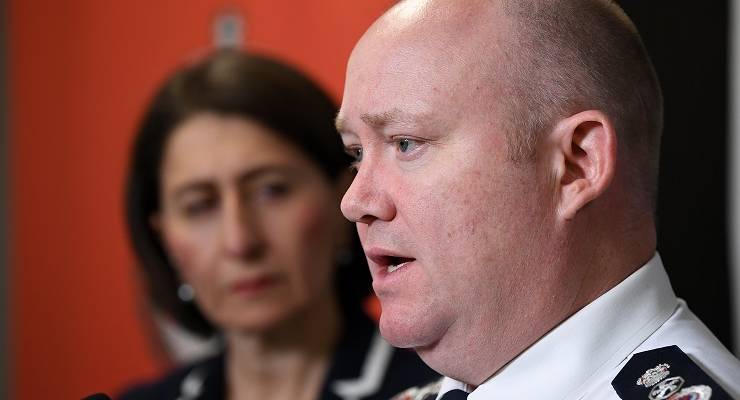
On Monday, Crikey wrote that the NSW fire service’s budget has been slashed since last year. To put it lightly, Rural Fire Service Commissioner Shane Fitzsimmons disagrees.
“It is rubbish, it is misinformation, it’s being misrepresented and I think it’s being disgracefully misrepresented here today in these sorts of circumstances,” he said in a press conference.
Fitzsimmons added the organisation was “enjoying record budgets”, without really explaining how.
So, who was right?
In our initial analysis, we only took into account the expenses budget. Fire and Rescue NSW (FRNSW) lost $12.9 million in expenses between 2018-19 and 2019-20, while the Office of NSW Rural Fire Services (NSW RFS) lost $26.7 million in expenses.
The $12.9 million cut to FRNSW stirred heated debates in parliament, with politicians understandably concerned about reduced firefighting capabilities.
If we take into account both expenses and capital expenditure, the difference between the last two budgets is even greater — $41.4 million for for FRNSW and $76.6 million for NSW RFS.
That’s a total of $118 million.
In August this year, member for Holsworthy Melanie Gibbons said in NSW parliament that “the government is investing a whopping $1.7 billion in emergency services”, and pointed to “$826 million in Fire and Rescue NSW alone”.
But this is still a decrease from the $867.6 million FRNSW received in 18-19.
The office of the NSW State Emergency Service (SES) did see an increase of $33.2 million in 19-20, but SES volunteers don’t attend fire jobs.
| Fire & Rescue NSW (FRNSW) | Office of the NSW Rural Fire Service (NSW RFS) | |
| 2018-2019 budget (revised) | ||
| Expenses | $787.2m | $551m |
| Capital expenditure | $80.4m | $66.3m |
| Total | $867.6m | $617.3m |
| 2019-20 budget | ||
| Expenses | $774.3m | $524.3m |
| Capital expenditure | $51.9m | $16.4m |
| Total | $826.2m | $540.7m |
| DIFFERENCE | –$41.4m | –$76.6m |
Spokespeople for FRNSW said a $28.5 million drop in the 19-20 capital budget was mainly due to one-off funding in 18-19 for programs, aerial appliances and training props, totalling $34.4 million.
The change in expenses was explained as a boost of $34.6 million in insurance in 18-19 after presumptive legislation was passed to compensate firefighters who develop specific cancers. The figure was higher in 18-19 to cover retrospective claims, and was then reduced in 19-20 based on revised estimates.
Likewise, a spokesperson for the NSW RFS said there wasn’t a decrease in the 19-20 budget, but rather a one-off increase in the 18-19 budget thanks to $23.8 million for a training centre in Dubbo, a $26.3 million air tanker, and $21.5 million for a new headquarters in Homebush. That still leaves $5 million unaccounted for.
But these “one-off” boosts are far from uncommon. FRNSW has previously received $23 million for a new headquarters in Greenacre, along with $16.5 million new fire stations and station upgrades, $16.8 million for firefighting vehicles, and $5 million for training props.
NSW RFS also received “one-offs” for air tanker trials and fire stations throughout 15-16/16-17.
The takeaway? FRN NSW is not currently enjoying “record budgets”. The budget bounce happened last year. One-off investments dropped in 19-20, leaving a $118 million hole in the budget at a time when the services need it most.








Thank you for all the digging you have done on this issue Amber, this is a really excellent piece of journalism. This is why we subscribe to Crikey – for journalism that cuts through the spin and isn’t afraid of speaking truth to power.
I think Mr Fitzimmons does a great job, but his feeble attempts to succour his budget masters is entirely understandable.
I am sure he has noticed the vindictiveness various LNP governments have applied to organisations that dare to criticise them.
Good work Crikey, keep it up…maybe the ABC will start quoting and interviewing your journos rather than Murdoch propagandists.
Of course, Fairmind, Fitzsimmons is not going to contradict the Premier in public anymore than any public servant would dare cross Barilaro after his belligerent statement that more dams are going to be built and any public servant who disagrees, then there is the door!
This what the Senior Executive Service is about and why it was formed, basically to discourage frank and fearless advice to the relevant minister and the government.
Yes good work Amber & Crikey in delving beyond the spin, however this ABC 7.30 Report segment and the reaction to Greg Mullins and 23 former colleagues in his attempt to meet Morrison since April, is appalling .
https://www.youtube.com/watch?v=Kf00vJclEr0
Sooo, the next question is, why is this guy telling porkies? I can’t wait for his next tantrum.
Because they are afraid of being punished by a highly vindictive Librorts Party regime.
Public Service Funding 101 – what gets funded matters, what gets cut sucks.
Nice work Amber. A big part of Fitz’s job is flak catching and spin as much as to keep the troops happy as his political masters.
I’m sure the Murdochracy will follow the script.